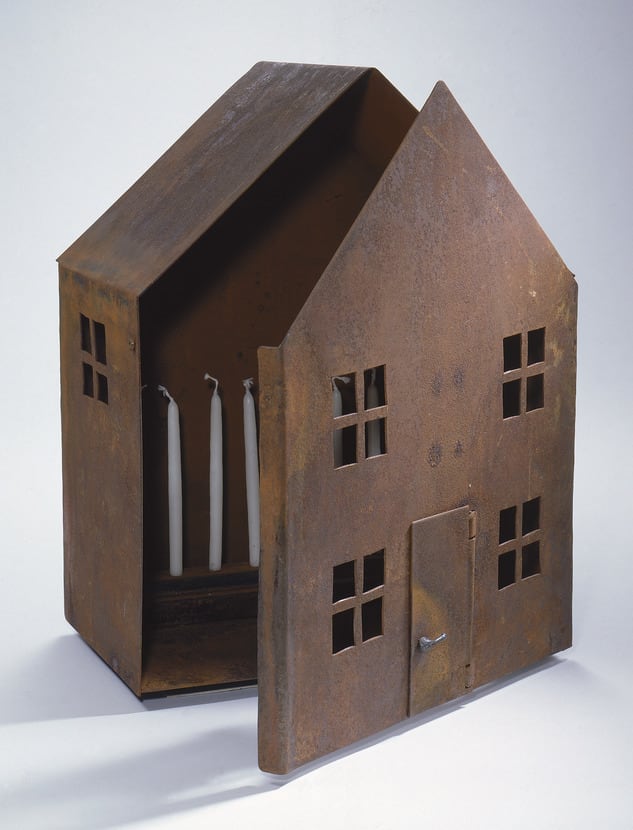
- Object Name:
- Hanukkah Lamp
- Artist/Maker:
- Rod Baer
- Bio:
- American, b. 1951
- Title:
- Every December
- Place Made:
- Los Angeles, California, United States
- Date:
- 1995
- Medium:
- Welded steel and mixed media
- Dimensions:
- Open: 15 7/8 × 12 × 15 in. (40.3 × 30.5 × 38.1 cm) Closed: 15 7/8 × 12 × 7 1/2 in. (40.3 × 30.5 × 19.1 cm)
- Credit Line:
- Gift of Alyne Salstone
- Accession Number:
- 1998-55
Not On View
Rod Baer earned his M.F.A. from the Claremont Graduate School in California, and has been active in the art world since the mid-1980s. Baer's sculptures and installations range in scale from small, intricately detailed works to large installation pieces. His art often incorporates everyday objects: books, chairs, TV sets, and so on, which he places in unusual settings and juxtapositions in order to create a dialogue about their meaning.
Rusted metal appears frequently in Baer's art and he uses the material to contrast the solidity of steel with the corrosion that occurs to its surface with the passage of time. The artist explains that "rusting objects... serve as both relics and homages… The density of steel imparts a solidity… while the exterior skin of active corrosion infers the evanescent and ephemeral."
Baer's Hanukkah lamp Every December, originally created for an invitational exhibition at the Jewish Museum of San Francisco, is highly unusual in a number of ways. Its architectural form suggests a humble, two-story house with mullioned windows and a slightly open door. Its rusted surface suggests age and the passage of years. The Hanukkah candles are placed within the structure, so that when lit, light pours through the door and windows creating a symbolic image of a cozy home ablaze with holiday light. Writes Baer, "Lighted candles of course have a certain universal symbolism, but for me Hanukkah is first and foremost a holiday of the home with the job of giving and taking tokens of love between family. From the outside you see a simple almost crude house, but it's the inside glow and sanctuary of a single family together basking in the radiance of the holiday candles that's the source and phenomenon of the story." Baer notes that "traditionally menorahs were set in the window for passers-by of the community to see, so that Every December actually harkens to the early days in more ways than one. I would like to say that I knew that and incorporated it into my idea, but I didn't. On the other hand when one joins the spirit of something, certain forces of symbiosis and intuition join in, so I'm happy with the overlap."
Baer's lamp is an embodiment of the home and the people who are part of the celebration of Hanukkah. For Baer, Hanukkah is a holiday of people, not of ceremony, and rather than creating the structure of a menorah-form Hanukkah lamp, the artist chose to emphasize the spirit of the holiday.
Rusted metal appears frequently in Baer's art and he uses the material to contrast the solidity of steel with the corrosion that occurs to its surface with the passage of time. The artist explains that "rusting objects... serve as both relics and homages… The density of steel imparts a solidity… while the exterior skin of active corrosion infers the evanescent and ephemeral."
Baer's Hanukkah lamp Every December, originally created for an invitational exhibition at the Jewish Museum of San Francisco, is highly unusual in a number of ways. Its architectural form suggests a humble, two-story house with mullioned windows and a slightly open door. Its rusted surface suggests age and the passage of years. The Hanukkah candles are placed within the structure, so that when lit, light pours through the door and windows creating a symbolic image of a cozy home ablaze with holiday light. Writes Baer, "Lighted candles of course have a certain universal symbolism, but for me Hanukkah is first and foremost a holiday of the home with the job of giving and taking tokens of love between family. From the outside you see a simple almost crude house, but it's the inside glow and sanctuary of a single family together basking in the radiance of the holiday candles that's the source and phenomenon of the story." Baer notes that "traditionally menorahs were set in the window for passers-by of the community to see, so that Every December actually harkens to the early days in more ways than one. I would like to say that I knew that and incorporated it into my idea, but I didn't. On the other hand when one joins the spirit of something, certain forces of symbiosis and intuition join in, so I'm happy with the overlap."
Baer's lamp is an embodiment of the home and the people who are part of the celebration of Hanukkah. For Baer, Hanukkah is a holiday of people, not of ceremony, and rather than creating the structure of a menorah-form Hanukkah lamp, the artist chose to emphasize the spirit of the holiday.
Information may change as a result of ongoing research.